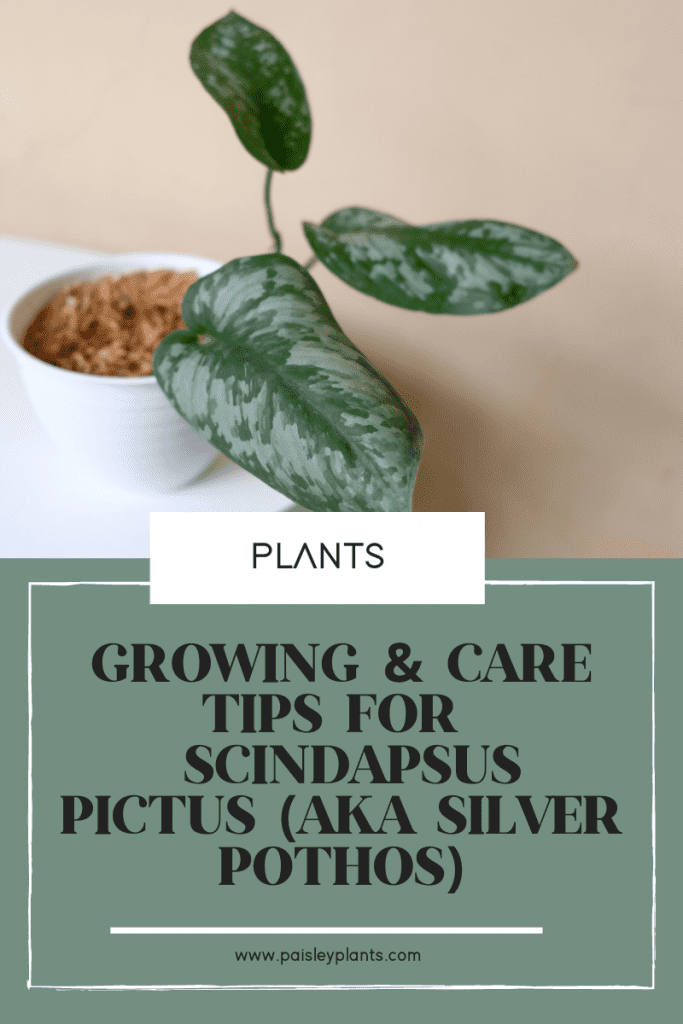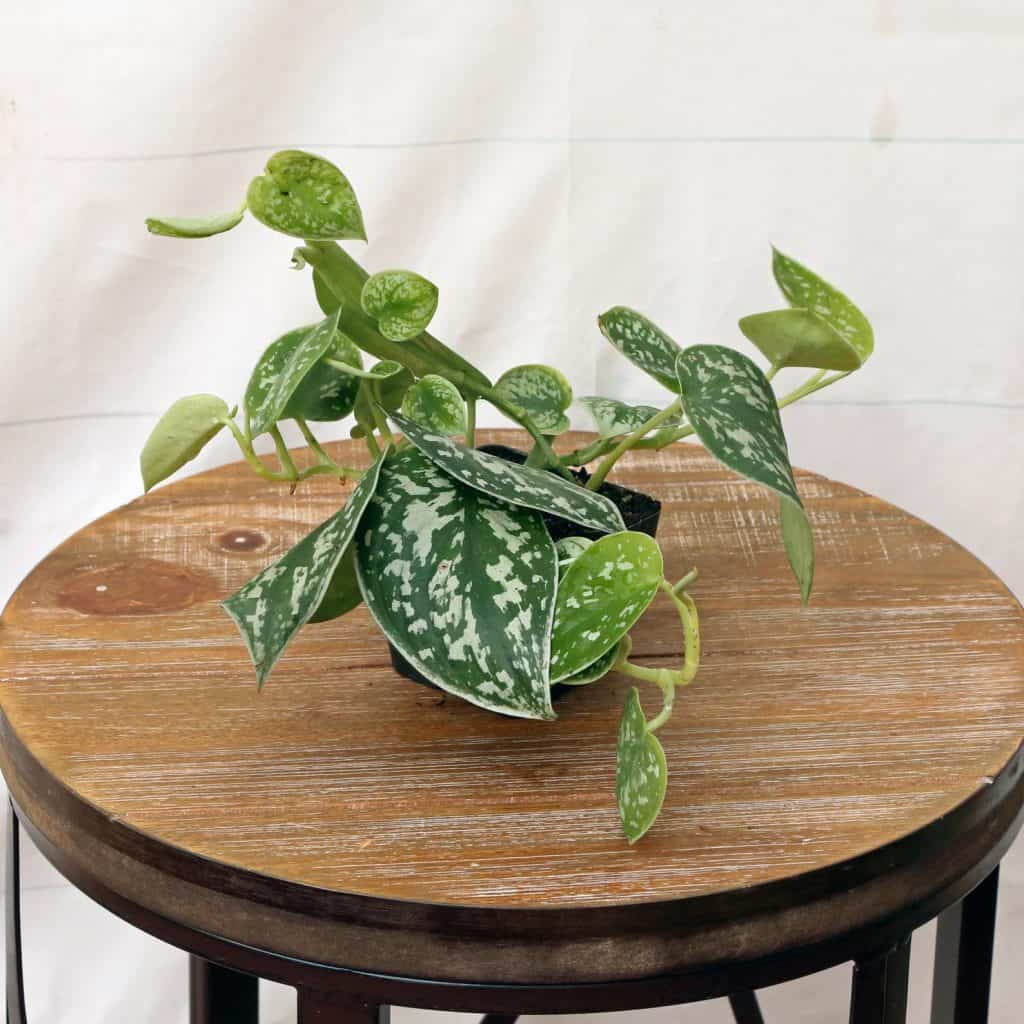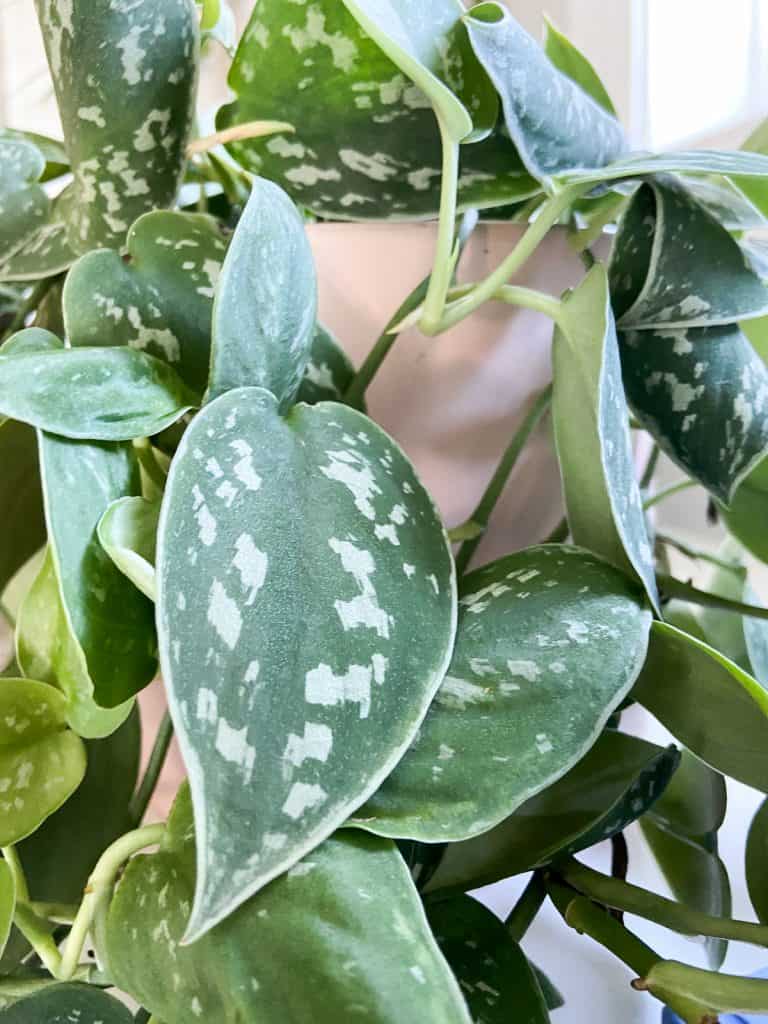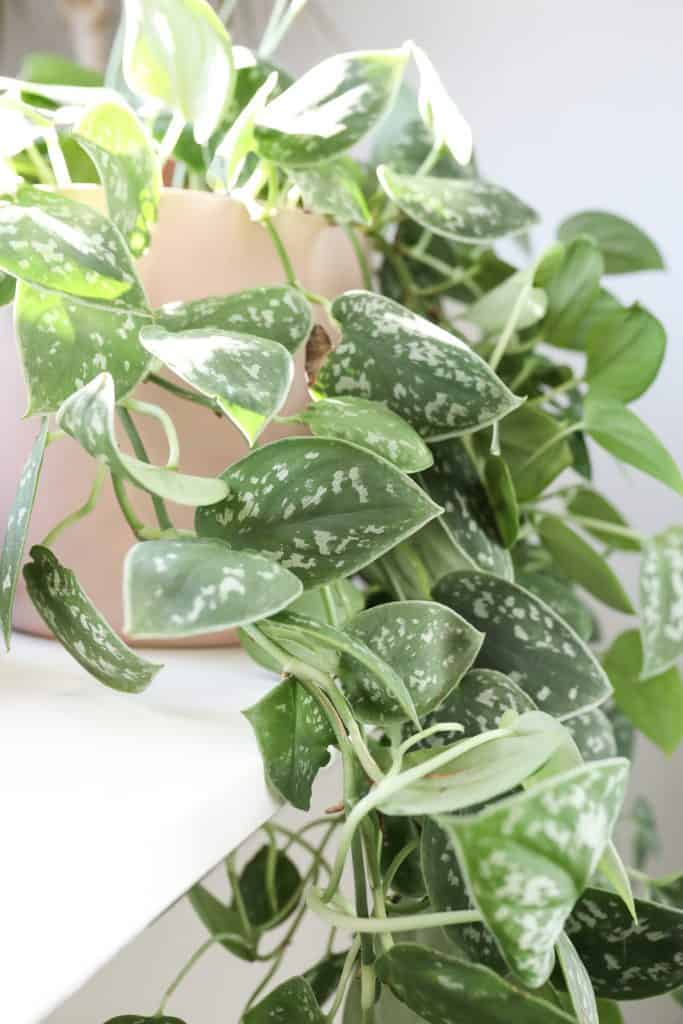Scindapsus Pictus ‘Argyraeus’ also known as Satin Pothos are species to be admired. Clearly you’re a fan since you’re here…and so am I! Let’s dive deeper into the world of Scindapsus Pictus.
Scindapsus Pictus or the more common name, satin pothos, is a vine plant that has dark green, heart-shaped leaves. Distinct silvery markings variegate each leaf.
Silver satin is simply known as silver pothos but oddly enough, it’s botanically not a pothos nor a philodendron. It’s a slow-growing, long trailing plant that can climb mosses or cascade elegantly down a wall-mounted basket.
This tropical plant is easy to care for: the plant needs soil that drains well and is nutritious. The plant does best in medium to high humid conditions, especially when combined with bright sunlight. Do you want to know more details about how to take care of silver satin? Continue reading the article.
Table of Contents
History of Scindapsus Pictus

Paisley Plants is a participant in the Amazon Services LLC Associates Program, an affiliate advertising program designed to provide a means for sites to earn advertising fees by advertising and linking to Amazon.com. This post may include affiliate links which means I may earn a small commission if you shop using the links below at no additional cost to you.
Scindapsus pictus, silver pothos, the satin pothos, or silver vine, is a flowering plant species in the arum family Araceae, native to India, Bangladesh, Thailand, Peninsular Malaysia, etc.
The world pothos is from ‘pictus,’ which translates to ‘painting.’ The painting here refers to the unique variegation on the foliage of each matte-green leaf.
The plant has its origins in the tropical forests of southeast Asia. The long stem of the plant can reach up to ten feet. But, you can prune the branch to maintain the ideal height.

Care Tips
Scindapsus Pictus is easy to care for due to its tropical properties. We will explore them in detail below.
Water
It is important to remember that you should only water the plant if the soil’s top layer has dried. You can test for this by pressing your finger against the potting mixture. If your hand gets damp from pressing on the mix, it signifies that the plant does not need more water right now, and you should leave it for a few more days.
Silver Pothos’ need for water varies with season. In winters, you only need to water the silver satin once a week or once every two weeks, just enough to keep the potting mixture slightly moist.
In summer, the plant consumes more water, and you usually have to water the plant twice a week.

Another test for water level is to check the soil near drainage holes. If that soil is wet, the plant at that moment does not need more water.
READ: Lucky Bamboo Plant Care – Growing Tips
Apart from these, there are a few more factors that impact how often you water the plant.
- The type of pot: if the plant is growing in plastic or ceramic containers, there will be less water evaporation than the plant placed in terracotta pots. For that reason, it is crucial which vessel you choose for your plant.
- The air temperature: plants respire more in hotter weather and release more moisture as well. For this reason, the plant needs more water in summers than in winters.
- The type of soil: the quality of the ground determines the hydration of the plant. A low-quality potting mix will require frequent hydration of the plant as compared to high-quality soil.
Light
Scindapsus plants grow well in plenty of bright, indirect sunlight. However, do not put the plant in direct sunlight as it will cause the leaf to lose its precious and distinct variegation patterns on the matte green foliage.

Image from Etsy (Florida Plants Gardens) – You can buy one there too!
It is better to put the plant on the window where it can receive some morning sunlight. Some morning sunlight can help with the better growth of the plant.
Silver satin is capable of growing in low-light. You will soon realize that the leafage vines start to decrease, and the plant starts to lose its vibrance.
Soil
Silver satin pothos loves a potting mix that is rich in nutrients and drains well. The excellent drainage properties will prevent the bacteria from growing in the soil and stop the potting mix from turning soggy and water-logged.
You should use a good household all-purpose soil. What defines good soil is its ability to hold moisture, but at the same time, the organic substance should be light so that the water drains efficiently.
If you don’t trust the brands on providing the best food for your beloved plant? You can prepare potting mix yourself by adding soil, perlite, and peat moss in equal quantities.

Preparing the complete potting mix is a technical job and requires experience. If the water drains too quickly, water the plant frequently and add some more peat moss to the mix because peat moss helps retain moisture. On the contrary, if the water takes longer than expected to drain from the compost, you should aerate the soil.
Temperature
Silver Satin Pothos is a warm-weather plant. Keeping it around 65 to 85 degrees Fahrenheit will help with growth. This constant average room temperature will mimic its native environment, helping the plant grow and thrive.
Avoid sudden changes in temperatures. Big jumps or drops can shock the plant and often lead to serious problems. Keep the plant out of cold drafts and inside during the winter if you live in a cold region.
Humidity
Since Silver satin is a tropical plant, it requires humid conditions to flourish. Those humid conditions are impossible to provide naturally. But, you can always use a room humidifier or mist the leaves.
Research shows that 40% humidity is optimum for the fastest growth. If the conditions are too humid, the mixture will be infested by fungus, bacteria, and larvae, causing the plant to go soggy and eventually die if you do not replace the combination.

Toxicity
The plant is toxic to cats, dogs, and various other household pets. It is due to its excretion of insoluble calcium oxalate. Ingestion of this substance will cause swelling of the oral cavity, vomiting, drooling and difficulty swallowing.
READ Goldfish Plant Care | Columnea gloriosa
Air Purification
The Scindapsus Pictus has a large surface area to volume ratio, ensuring that the leaves absorb maximum sunlight and carbon dioxide from the environment. What this does is essentially purify our air for you.
While humans primarily need oxygen, plants need carbon dioxide to survive. Furthermore, the dark green leaves of the plant do not let any light pass through without absorption. Pothos is one of the most effective natural air purifiers.
Common Problems With Scindapsus Pictus
This plant is often at risk of pests and diseases due to overwatering. Too much water can lead to root rot. A sign of root rot is damage to the stems, which turn brown. Overwatering will also produce soft or black spots on the leaves.

If your plant holds too much water, it may be at risk of fungal leaf growth, which is dangerous to its health. If this happens, trim away what’s infected and don’t overwater again.
There are only so many times you can do this, however, so be sure to take special care of your Silver Satin Pothos! The only way to revive a plant after this is to put it in new potting soil.
Signs of root rot appear quite late. The leaves start turning brown and yellow. The stem has turned soft, and there are various black spots all over it. When this happens, it is possibly too late.
But, repotting the mixture to a nutrient-rich, well drainage, sterile soil may cause the plant to recover.
Pests are also a common problem. The two most common issues are scale and spider mites. It’s easy to tell when these arrive, and you must handle them quickly to take care of the plant. If you wait, they can easily infect and kill the plant. Look for little dots or bumps on your plant’s leaves, tiny webs, or sooty mold.
Where to Buy:
Conclusion
Scindapsus Pictus is growing popular each day due to its beautiful variegated foliage, its ability to clean the air of the environment you keep it in, and many more reasons.
We hope that we were able to add some information to your knowledge about Scindapsus. Get yourself a Satin pothos because why not?

